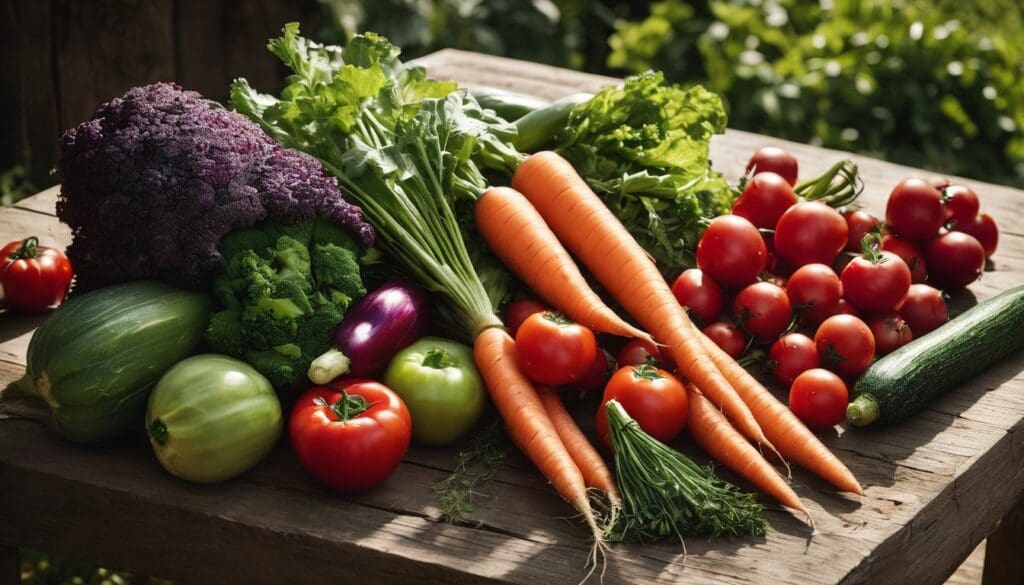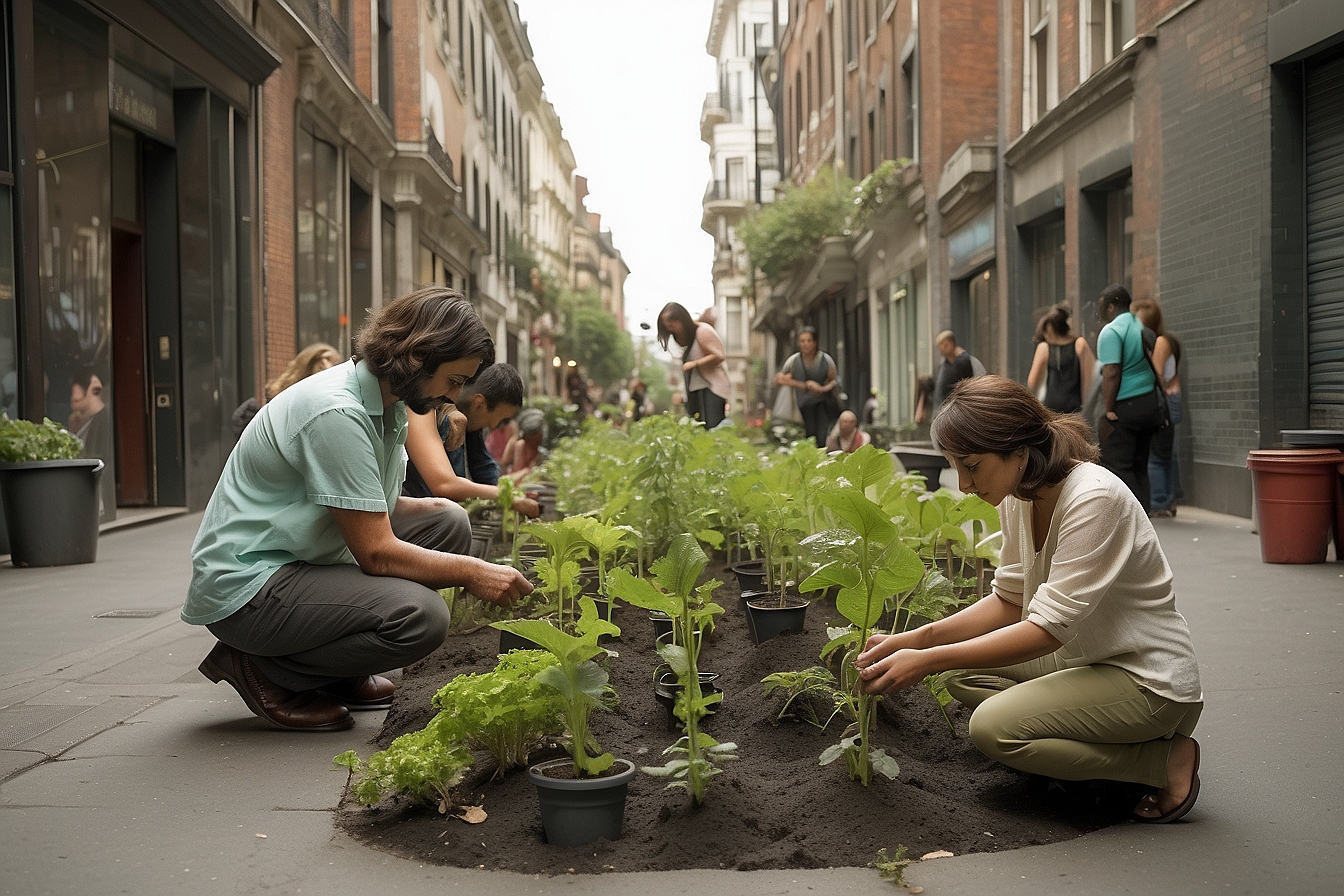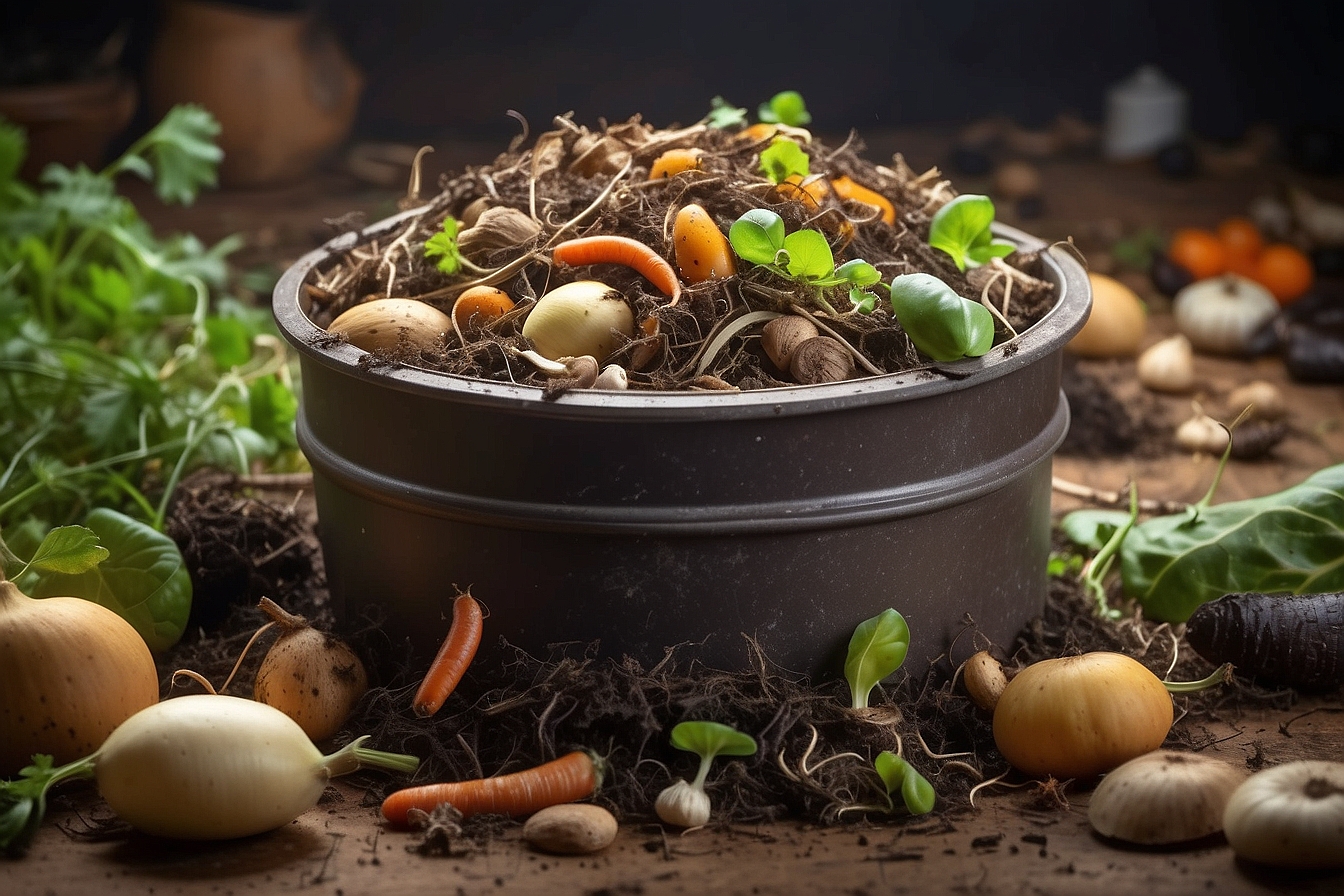Ever paused, mid-forkful, to ponder the journey of your food? It’s a common musing that many of us share, particularly when we consider that our evening repast has often voyaged an astonishing 1,500 miles before gracing our plate.
Our guide is here to illuminate the delights and advantages of organic gardening, offering you a ticket to join this green-fingered revolution. By cultivating your own plot of land, you can harvest the freshest and most nourishing produce without stepping further than your garden gate.
So let’s roll up our sleeves and get stuck in!
Key Takeaways
- Organic gardening promotes health by providing fresh, chemical – free produce and supports environmental conservation through reduced use of harmful pesticides.
- Practical steps to start organic gardening include selecting a sunny location, preparing the soil with compost, choosing suitable plants for the climate, and using natural pest control methods.
- Small spaces can become productive food sources via container gardening or participation in community gardens; home composting further enhances sustainability efforts.
- Resources like books, organic gardening websites, and newsletters alongside joining local communities provide valuable support and ongoing learning for eco-friendly gardeners.
- Organic farming practices such as crop rotation and companion planting improve soil health while reducing pests naturally without harming beneficial insects.
Benefits of Growing Your Own Food Organically
Growing your own food organically has numerous benefits, including improved health from eating fresh, chemical-free produce and cost savings from not buying expensive organic fruits and vegetables.
Additionally, it also has a positive impact on the environment by reducing carbon footprint and promoting sustainable agriculture.
Health benefits
Eating fresh, homegrown produce from our organic garden adds a powerhouse of nutrients to our diet. The absence of harmful pesticides means what we put on the table is much safer for our bodies.
Growing food organically supports soil health and ensures that the vitamins and minerals in our vegetables and fruits are at their peak.
We take control of what goes into our meals by nurturing each plant without synthetic chemicals. By choosing organic gardening, we also embrace eco-friendly practices that benefit not just us but the planet too.
Let’s now explore how growing your own food can be easier on the wallet with some insightful cost savings strategies.
Cost savings
Transitioning from the health benefits of growing your own food to cost savings, it’s important to consider the financial perks of organic gardening. By cultivating your own produce, you can significantly reduce your grocery expenses while enjoying a bountiful harvest of fresh, nutritious fruits and vegetables.
This not only aids in promoting sustainable living but also offers a budget-friendly approach to obtaining high-quality organic food. Embracing sustainable gardening practices at home allows for substantial long-term savings on grocery bills and ensures access to locally grown, eco-friendly produce without breaking the bank.
Environmental impact
Organic gardening has a positive environmental impact, reducing the use of harmful chemicals that can leach into the soil and waterways. By choosing organic methods, we protect biodiversity and contribute to healthier ecosystems.
Additionally, organic gardening helps in reducing our carbon footprint by avoiding the transportation emissions associated with store-bought produce.
Looking for Tips for Growing Organic Food in Small Spaces? Let’s explore some creative options to maximise your urban garden space.
How to Get Started in Organic Gardening
Select a sunny and well-drained site for your garden, and prepare the soil by incorporating organic matter and compost. Choose organic plants that are adapted to your climate and water them regularly, avoiding chemical fertilisers.
Selecting the right site
When choosing a site for your organic garden, consider a location that receives at least 6 hours of sunlight per day. Ensure the area has good drainage to prevent waterlogging and select a spot with minimal wind exposure to protect delicate plants from damage.
Look for a level site to aid in water distribution and make gardening tasks more manageable.
Evaluate potential sites according to their proximity to your home for easy access and monitoring. Take into consideration existing obstacles such as trees, buildings, or structures that may cast shade or compete for nutrients.
Preparing the soil
When preparing the soil for organic gardening, ensure that it is well-draining and rich in nutrients. Start by removing any weeds, rocks, or debris from the area where you plan to plant.
Dig over the soil with a garden fork to break up heavy clumps and improve aeration. Incorporate organic matter such as compost or well-rotted manure to enhance soil structure and fertility.
This will promote healthy root growth and encourage beneficial microorganisms in the soil.
Consider conducting a soil test to determine its pH level and nutrient content. Based on the results, amend the soil with natural materials like lime to adjust pH levels or bone meal for phosphorus deficiency.
Choosing organic plants
When selecting organic plants for your garden, consider starting with local nurseries or farmers’ markets to find a variety of organic seeds and seedlings. Look for reputable suppliers that offer certified organic plants, free from synthetic pesticides and GMOs.
It’s also worth exploring heirloom varieties, which are time-tested and often possess excellent flavour and resilience. Be sure to match the plants you choose with your specific growing conditions; take into account factors such as sunlight exposure, soil type, and climate suitability.
By handpicking the right organic plants for your garden, you can set yourself up for success in cultivating healthy, sustainable produce.
Watering and fertilising
To maintain an organic garden, we need to pay attention to watering and fertilising. Here are important tips to consider:
- Water your plants deeply but less frequently, encouraging deep root growth and drought tolerance.
- Use a drip irrigation system to deliver water directly to the base of plants, reducing evaporation and water waste.
- Mulch around plants to help retain moisture in the soil and reduce the need for frequent watering.
- Collect rainwater in a barrel for sustainable irrigation.
- Fertilise with organic compost, manure or natural plant-based fertilisers to provide essential nutrients without harmful chemicals.
- Consider making your own organic liquid fertiliser from compost or seaweed for an extra nutrient boost.
Maintaining an Organic Garden
Using natural pest control methods like companion planting and introducing beneficial insects is essential for keeping your organic garden healthy. Implementing crop rotation and regularly weeding and cleaning the garden are also key factors in maintaining a successful organic garden.
Using natural pest control methods
To maintain an organic garden, we employ natural pest control methods such as introducing beneficial insects like ladybirds, lacewings, and predatory mites. These insects feed on harmful pests like aphids, caterpillars, and spider mites.
Additionally, we also use neem oil and insecticidal soaps to deter common garden pests while being mindful of their impact on beneficial insects. By implementing these natural strategies rather than chemical pesticides, we can support a healthy ecosystem in our gardens.
Furthermore, planting companion crops such as marigolds and nasturtiums can repel pests through their scent or by deterring them from neighbouring plants. We also encourage biodiversity by incorporating diverse plant species in our gardens to attract a wide range of pollinators that aid in pest control naturally.
Crop rotation
Crop rotation involves systematically planting different crops in the same area from one season to the next. This practice helps improve soil fertility, manage pests and diseases, and reduce the need for chemical fertilisers and pesticides.
By alternating plant families, we can disrupt pest life cycles and prevent the depletion of specific nutrients in the soil, contributing to healthier plants that are more resistant to disease.
We rotate our crops by dividing our garden into sections and rotating between nitrogen-fixing legumes like peas or beans with heavy feeders such as tomatoes or corn. Additionally, we include cover crops like clover or rye during fallow periods to enhance soil structure and fertility further.
Weeding and cleaning the garden
To maintain an organic garden, we regularly weed and clean the garden beds to remove any unwanted plants and debris. We use hand tools or simple hoes to pull out weeds, ensuring that we get rid of them at the root level to prevent regrowth.
Clearing away fallen leaves, twigs, and other organic matter helps reduce the risk of pests and diseases in our garden. By keeping our garden tidy and free from potential threats, we promote a healthier environment for our plants to thrive.
Using natural pest control methods is key in managing pests effectively without harming beneficial insects or impacting the environment negatively. These methods include introducing beneficial insects like ladybugs or lacewings for pest control.
Tips for Growing Organic Food in Small Spaces
– Utilise container gardening techniques to grow vegetables and herbs on balconies or patios, making the most of limited space.
– Consider participating in community gardens as a way to access shared land for growing organic produce while connecting with other like-minded individuals.
Container gardening
Container gardening is a great way to grow organic food in small spaces such as balconies, patios, or urban rooftops. By using containers like pots, buckets, or window boxes, individuals can easily cultivate herbs, vegetables, and even some fruits.
This method allows for flexibility in moving plants to optimal sunlight and protection from weather conditions. It also provides an opportunity to control soil quality and utilise space efficiently.
In container gardening, it’s essential to choose the right-sized pot for each plant variety to ensure proper root development and growth. Additionally, selecting high-quality organic soil and regular watering are crucial for healthy plant growth.
Community gardens
Community gardens offer a fantastic opportunity for environmentally conscious individuals to grow their own organic food, even if they don’t have access to a large outdoor space. These shared spaces provide a sense of community while promoting sustainable practices such as composting and reducing food miles.
Working alongside others in the garden also offers an excellent chance to learn about different growing techniques and share knowledge about eco-friendly gardening.
By participating in community gardens, we can contribute to the locally grown food movement, support conservation efforts, and foster a deeper connection with nature. Additionally, these spaces often serve as hubs for educational workshops and events that promote organic farming techniques and self-sufficiency in gardening.
Composting at home
When composting at home, we can recycle kitchen and garden waste into nutrient-rich soil for our organic garden. By layering brown (carbon-rich) materials such as dry leaves with green (nitrogen-rich) scraps like food peelings, grass clippings, and coffee grounds, we create the perfect conditions for decomposition.
Regularly turning the pile helps aerate it and speed up the process. This eco-friendly approach not only reduces household waste but also enriches our soil naturally.
We encourage environmentally conscious individuals to consider small-scale composting in urban areas using bins or tumblers. This supports conservation efforts by reducing landfill contributions while providing a sustainable source of natural fertiliser for our homegrown produce.
Resources and Further Learning
Explore organic gardening websites, books and guides, join a gardening community, and subscribe to newsletters for ongoing support and learning. Keep expanding your knowledge to grow your own food organically!
Organic gardening websites
For those of us who are environmentally conscious and support conservation efforts, finding reliable resources for organic gardening is crucial. Here are some top organic gardening websites to explore, along with their key features and resources:
- Organic Gardening Magazine’s website offers a wide range of articles on organic gardening techniques, plant care, and sustainable practices.
- The Royal Horticultural Society’s website provides advice on growing organic plants, controlling pests naturally, and creating wildlife-friendly gardens.
- The Soil Association’s website is a valuable source for information on soil health, composting, and the benefits of using organic seeds and plants.
- Mother Earth News hosts an array of videos, tutorials, and expert tips on all aspects of organic gardening, from soil preparation to harvest.
- The Organic Trade Association’s website offers insights into the importance of supporting local farmers and choosing organic produce for a healthier lifestyle.
- The National Gardening Association’s website features forums where you can connect with fellow gardeners to share experiences and knowledge about organic gardening methods.
- Garden Organic’s website presents resources for starting a community garden or joining existing initiatives focused on urban farming and sustainable living.
- Permaculture.co.uk provides in-depth articles on permaculture design principles, natural building techniques, and creating self-sufficient ecosystems in your own backyard.
Books and guides
When looking for further learning in organic gardening, environmentally conscious individuals can explore various books and guides that provide in-depth knowledge and practical tips. Here are some valuable resources to consider:
- “The Vegetable Gardener’s Bible” by Edward C. Smith – This comprehensive guide offers expert advice on growing a wide variety of vegetables organically.
- “Rodale’s Ultimate Encyclopedia of Organic Gardening” by Fern Marshall Bradley – A go-to reference covering everything from soil health to pest control using natural methods.
- “Square Foot Gardening” by Mel Bartholomew – This popular book provides a simple and efficient approach to maximise yields in small spaces.
- “The New Organic Grower” by Eliot Coleman – A must-read for those interested in sustainable farming practices and organic gardening techniques.
- “Carrots Love Tomatoes” by Louise Riotte – An insightful guide on companion planting to maximise plant health and productivity.
- “Gaia’s Garden: A Guide to Home-Scale Permaculture” by Toby Hemenway – This book introduces the concept of permaculture, offering innovative approaches for sustainable garden design and management.
Joining a gardening community
Join a gardening community in your area to connect with like-minded individuals who share your passion for organic gardening. This provides an opportunity to exchange valuable tips, tricks, and advice on sustainable practices.
By joining a community, you can attend workshops and events focused on eco-friendly gardening methods, expanding your knowledge and skill set. Engage in discussions about environmental conservation while sharing experiences and learning from others’ successes and challenges.
Participating in a gardening community also offers the chance to collaborate on group projects such as communal gardens or urban farming initiatives. Through networking with local gardeners, you may discover new resources, access organic seeds or plants from fellow members’ harvests, or even coordinate seed swaps for variety in homegrown produce.
Subscribing to newsletters.
After joining a gardening community, staying updated and expanding your knowledge is essential. Subscribing to newsletters provides valuable information on the latest organic gardening trends, tips for growing food in small spaces, and updates on eco-friendly practices.
These newsletters often include exclusive content such as interviews with experienced gardeners, reviews of new gardening products, and invitations to local events or workshops.
By subscribing to newsletters from reputable sources, you’ll keep abreast of the best practices in organic gardening while connecting with a wider community of like-minded individuals.
Conclusion
In conclusion, organic gardening offers many benefits for those looking to grow their own food. The health advantages of consuming fresh, chemical-free produce are significant. By following the principles of organic gardening, we can reduce our environmental impact and contribute positively to conservation efforts.
Becoming self-sufficient in growing our own food also leads to cost savings and a sense of satisfaction from producing homegrown meals. With the right knowledge and resources, anyone can start an eco-friendly garden no matter how small their space may be.
FAQs
1. What is organic gardening and how does it support self-sufficiency?
Organic gardening means growing your own food using ecofriendly methods, allowing you to be self-sufficient by providing fresh produce right from your garden to table.
2. Can I practice organic gardening in a city environment?
Absolutely! Urban gardening techniques allow you to cultivate homegrown food even with limited space, like balconies or small backyards.
3. Is DIY gardening expensive?
Not at all; DIY gardening can be quite economical as you use everyday items for planting seeds and creating compost, making it a budget-friendly way to grow your own food.
4. How does backyard farming contribute to ecofriendly living?
Backyard farming avoids the use of harmful chemicals, reducing pollution and creating an ecofriendly space that produces healthy, organic food for your family.
5. What are the benefits of farm-to-table dining at home?
When you embrace farm-to-table dining at home through organic gardening, you enjoy fresh and nutritious meals while contributing positively to the environment by cutting down on food miles.





